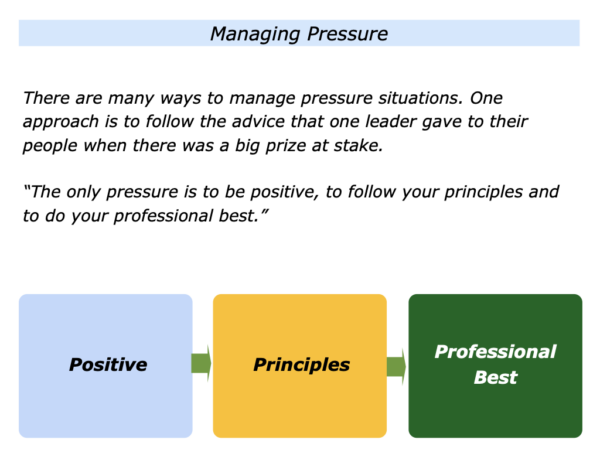
There are many ways to do fine work. Some people focus on the specific activities where they play to their strengths and get pleasure from managing pressure situations.
Different people will do this in different situations. They may enjoy working in Accident & Emergency, playing sport at a high level or doing certain kinds of challenging activities.
Some people feel fully alive when working in what others see as pressure situations. Moving into action, they use their antennae to keep reading the situation and applying their abilities to achieve positive results.
They feel comfortable in certain kinds of pressure situations but not in others. One person expressed this in the following way.
“I feel alive and in control when doing certain kinds of work. It helps me to keep growing as a person and as a professional.”
People who do good work in their chosen pressure situation often demonstrate the required character, competence and creativity. They apply these qualities to deliver the required concrete results. Sometimes they also add that touch of class.
Some people follow the mantra that is attributed to Billie Jean King. She saw playing in the final at Wimbledon as an opportunity. This led to her saying that sometimes pressure is a privilege.
Some people take another approach when embarking on doing work that could lead to prizes. They focus on the following mantra.
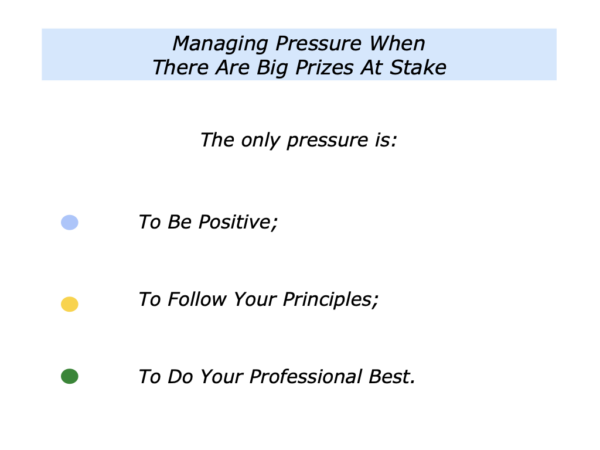
Different people follow this approach in different ways. Let’s explore how they may follow this mantra in different situations.
They Aim To Be Positive
Such people choose to have a positive attitude. They focus on the possibilities and opportunities. They then aim to do their best in the situation.
They take this positive approach rather than worry about what some would see as pressures. When asked if they worry, they may then give the well-known response.
“Will it help if I worry? Probably not. So I aim to do my best when doing positive things and also when tackling potential challenges.”
They play to their strengths and set positive goals. Bearing in mind what they can control, they clarify the real results to achieve. They then translate these into a clear picture of success. This leads to the next step.
They Aim To
Follow Their Principles
Such people clarify the principles they want to follow to work towards achieving the goals. Different people may follow different principles in different situations. Here are some that some people mention.
Principles – The principles that I
want to follow in my life or work are:
To build on my strengths … To always do my best … To encourage people … To follow strategies that work … To deliver high professional standards … To focus on continuous improvement … To do work that helps people or the planet.
They then focus on how they can follow their principles in a specific situation. This sometimes lead to the next step.
They Aim To Do
Their Professional Best
Such people aim to do their professional best in the situation. Different people may do this in different situations.
They may focus on doing their
professional best when they are aiming:
To counsel a troubled person … To manage a specific crisis … To perform in a sporting event … To mediate in a conflict situation … To perform a critical medical operation … To defuse a bomb … To tackle a daunting challenge.
They prepare properly. Moving into action, they are fully present and follow their chosen principles. They then do their professional best to achieve the picture of success.
Some people define this as doing their professional best rather than simply their personal best. One person expressed the reason for this in the following way.
“I often switch into professional role in certain situations and move into another dimension. I become alive, alert and use my antennae to focus fully on the task in hand.
“I tend to forget myself and, whilst still trying to be a compassionate person, clarify what needs to be done. I then do my professional best to achieve the picture of success.”
There are many ways to manage pressure situations. One approach is to say that the only pressure is: a) to be positive; b) to follow your principles; c) to do your professional best.
Looking ahead, can you think of a situation where you may want to follow elements of this approach? How can you do this in your own way? Let’s look at another approach to manage pressures.
The Managing Multiple
Challenges Approach
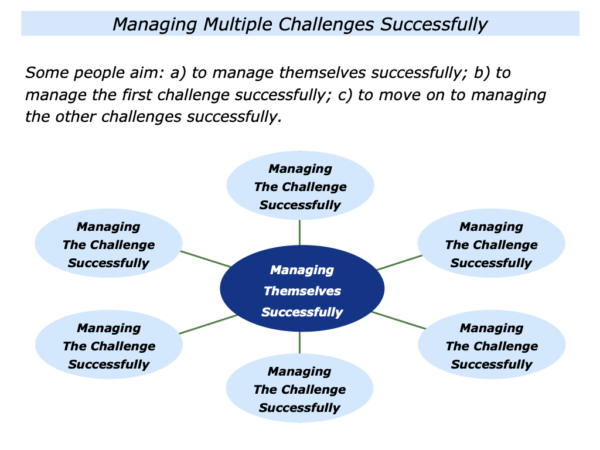
People sometimes face multiple challenges in their personal or professional lives. Some people take the following approach to managing such situations:
They manage themselves successfully;
They manage the first challenge successfully;
They move on to managing each of the other challenges successfully.
A person may take this approach in their personal life when managing several issues at once. They may take it in their professional life when working as a paramedic, a mediator, a crisis manager or in another role.
Different people follow this approach in different ways. Let’s explore how they may translate these principles into action.
They manage
themselves successfully
Some people start by managing themselves properly when approaching a challenge. Depending on the kind of situation they may be facing, this can involve going through the following steps.
They manage themselves physically. They may rest, sleep or get into a certain physical condition. They aim to feel on top of their game when tackling the challenge.
They manage themselves psychologically. They have a positive attitude and focus on how they can manage their emotions on the way towards achieving their goal.
They manage themselves practically. They set things up to succeed by getting the required resources and putting in place the practical things that will increase the chances of achieving success.
People who take this approach may then choose to tackle certain kinds of pressure situations or challenges. They may take either of the following steps:
They may choose to proactively put themselves into challenging situations;
They may choose react to certain events by taking responsibility for tackling challenging situations.
Such people may display certain characteristics when managing themselves in certain situations. Let’s look at one example.
People Who Defuse Bombs
Many people feel passionately about their work. Some individuals can work better, however, when managing their emotions. They are then more able to concentrate and be fully present when doing the work.
Bomb disposal experts, for example, often drain themselves of emotion and focus on the job in hand. This is especially so when advancing towards the device on what is known as ‘the longest walk’.
Ed Chipperfield and James Day describe the qualities demonstrated by such workers in their article called What does it take to survive as a bomb disposal expert? Below are excerpts from the piece.
In a situation where the only outcomes are success or failure, psychologists say these soldiers require a certain mindset.
“We want people who minimise the unknowns,” says Eugene Burke, a military psychologist.
“They’re not impulsive but are able to make fast decisions, thanks to training. It’s almost as though they’re flicking through reference cards in their head to find a match to the problem in front of them.
“They’re organised, focused on detail and think ahead to possible outcomes. Allowing stress to build up is not an option as the operative can become withdrawn and lose their temper.”
Imagine that a person had done what they can to manage themselves successfully. They may then move on to the next stage.
They manage the first
challenge successfully
They focus on the first challenge they want to tackle. They recognise, however, that it may also be necessary to manage other related issues.
They start by clarifying the real results to achieve. They then rehearse the strategies they can follow to give themselves the greatest chance of success. They also rehearse dealing with any problems they may encounter when working to achieve their goals.
They then move into action. Bearing in mind the results to achieve, they follow their chosen strategies. They also keep reading reality. They aim: a) to keep building on what is working; b) to tackle areas for improvement
Such individuals buy time to think when faced by unexpected problems. They then aim to find solutions, do their best to manage the challenge and achieve the desired results.
They take time to reflect after completing the work. They clarify: a) the specific things they did well; b) the specific things they could have done better and how; c) the specific lessons they can apply to tackle future challenges.
They move on to managing
multiple challenges successfully
Some people move on to tackling multiple challenges. Such individuals may take the following steps:
They continue to manage themselves successfully;
They still focus on managing one challenge at a time – whilst managing any related issues – and manage the next challenge successfully;
They then emotionally box-off that challenge, move on to the next challenge and aim to manage it successfully.
Let’s look at another approach to managing pressures successfully.
The Professional
Reframing Approach
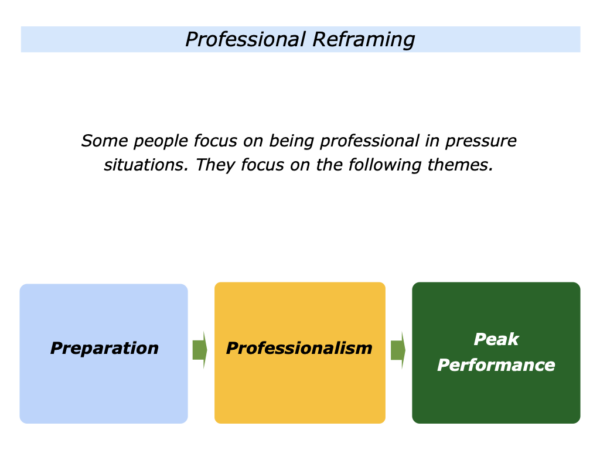
Great workers sometimes reframe pressure situations as professional situations. This is an approach sometimes taken by first responders, medics, athletes and others in challenging professions.
Bearing in mind what they can control, some individuals take the following steps:
They channel their emotions by reframing the event as a professional situation.
They aim to prepare properly, be professional and do their best to achieve peak performance.
Different people follow these steps in different ways. One of the keys, however, is to channel their emotions in a positive way. Let’s look at some examples.
First Responders
First responders in many professions learn how to stay calm and reframe situations. Virginia Duffy has helped many professionals to deal with difficult situations.
Below is an excerpt from her article Managing Emotions During Stressful Events. This piece describes how rescuers – such as firefighters, paramedics and others – can also care for themselves.
Remember emergency workers must deal with their own feelings first in order to best care for patients. Often we work on automatic and don’t experience much emotion until the situation is over; then the emotions may flood us.
There are times however when the situation may feel overwhelming to us especially when it “hits close to home.” The emotions felt by rescuers may include fear, anger, disgust, helplessness or the desire to leave.
Some strategies for dealing
with your own emotions
Take a few seconds to think and calm yourself. Talk to yourself: “I can do this. I have done this before, just focus on the job.”
Take a deep breath. Behaving as if you are calm will help to calm you. Force yourself to talk slow, move slow, be deliberate.
Direct your attention to the patient’s most immediate concern. Once you are past your initial emotional response, you are usually home free. But also ask for help if you need it.
Doing Your Best In Sports
Great athletes care deeply about doing their best. Sometimes they can become anxious and perform badly, however, by caring too much about winning the prize.
Such athletes often use certain mantras to remind themselves of what they can do when performing in their version of the arena. They may say some of the following things.
Be calm, controlled and centred … Keep following the process rather than worrying about the prize … Try easy rather than try hard … Flow, focus and finish.
Matthew Syed, the author of Bounce, gives an example of how this approach to perform at their best. Sarah Lindsay, the speed skater, took this step by maintaining perspective and following certain principles.
She spent years focusing on reaching the final of her event in the Winter Olympics. This called for beating her previous best performance. Sarah was seen preparing in the locker room before the final qualifying race saying the following things to herself.
“It’s only speed skating. It’s only speed skating. It’s only bloody speed skating.”
Sarah kept repeating the mantra. She then went out and performed beyond her previous best to reach the final.
Matthew goes on to describe how an athlete can overcome choking – continually failing to perform when it really matters.
As Mark Bawden, the sports psychologist who worked with Lindsay, put it:
“In order to make all the sacrifices necessary to reach world-class levels of performance, an athlete has to believe that performing well means everything.
“They have got to cleave to the belief that winning an Olympic gold is of life-changing significance. But that is precisely the belief that is most likely to trigger a choking response.
“So, the key psychological skill for someone with a tendency to choke is to ditch that belief in the minutes before competition and to replace it with the belief that the race does not really matter. It is a form of psychological manipulation, and it takes a lot of work to master.”
Let’s return to your own life and work. Looking ahead, can you think of a challenge that you can as reframe as a professional rather than a pressure situation?
How can you prepare properly for the situation? How can you behave in a professional way? How can you then do your best to achieve peak performance? What may happen as a result of taking these steps.
The Putting Positive
Pressure On Yourself Approach
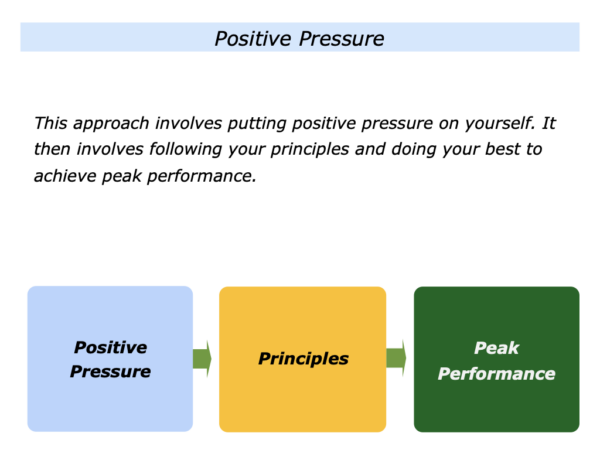
Let’s return to a variation of the model described at the beginning of this section. Some people choose to put positive pressure on themselves. They then aim to follow their principles and do their best to achieve peak performance.
We have explored these themes elsewhere in the book, so here is a brief overview. Such people often focus on the following themes.
Positive Pressure
Different people put positive pressure on themselves in different ways. Let’s look at some examples.
A writer may set a date for finishing their manuscript. They may then tell their publisher that they complete it by that date. This may force them to follow a certain rhythm to finish the book.
A person may plan to be a certain weight on their wedding day. They may then follow a specific diet to make sure they can get into the clothes they have ordered for the big day.
A leadership team may choose to clarify the principles they want to follow in a company. They may then focus on how they can live these principles in their daily work. This is an approach we well explore later in this piece.
Different people have different motives for putting positive pressure on themselves. Whatever their reasons, some may then move on to the next stage.
Principles
Great workers, teams and organisations believe in following their principles. This can be relatively easy when things are calm. The hard part is following them in stormy weather. It can therefore be useful to test how to follow the principles in challenging situations.
One company I worked with took this approach. The senior team began by involving key people across the business in agreeing on the principles to follow in the future. These included the following:
Take Responsibility … Be Professional … Help People Succeed … Deliver Great Results
The company held employee workshops where people explored how to translate these principles into action. It included this exercise.
The Principles Challenge
Choose a situation where it may be challenging to follow the principles.
Clarify the possible options for tackling the challenge together with the pluses and minuses of each option.
Clarify which of these possible options is the one where we can – as far as possible – follow our principles and translate these into action.
The employees threw themselves into the exercise and produced plans for tackling most scenarios. They did not consider one scenario, however, that soon presented the leader with a dilemma.
The Actual Challenge
One month after the workshop two senior staff members behaved in a way that violated the professional guidelines that had been communicated to staff.
The story about their behaviour spread across the company. People began to wonder if the company was serious about following the stated principles. The CEO had several options in the situation. Each option had pluses and minuses.
They could ignore the errant behaviour;
They could give the senior staff members a warning and hope it was a one-off;
They could show they were serious about following the principles and replace the senior staff members.
The CEO chose the third option. This surprised many people and created some short-term shocks, but it was beneficial in the medium to long-term. It showed they were serious about building and maintaining a positive and professional company.
This highlights a key point. Great workers keep going back to their principles – which act as a guiding compass – especially during crises. This can lead to the next stage.
Peak Performance
Imagine that you have followed your chosen principles. You may then aim to follow these principles and do your best to achieve peak performance.
Different people do this in different ways. Some people follow the approach described by Robert Kriegel and Marilyn Harris Kriegel in their book The C Zone: Peak Performance Under Pressure.
People who take this route aim to be calm, controlled and centred. They then commit themselves to pursuing their chosen strategy to achieve their goals.
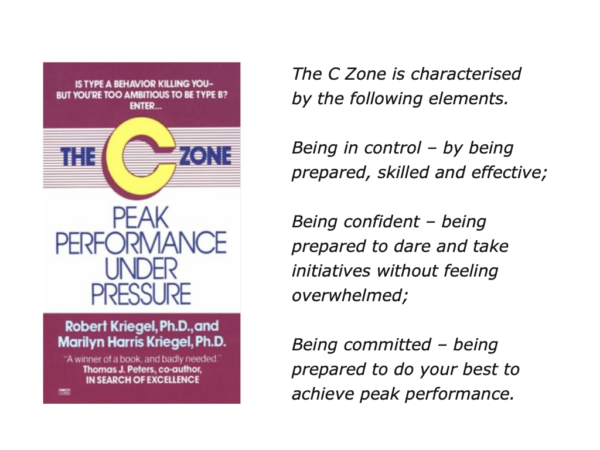
Some people have added their own C words to this approach. They aim to stay calm and focus on the following steps.
Control
They have a positive attitude but are also good at reading reality. They clarify what they can control in the situation. They then aim to build on what they can control and manage what they can’t.
Clarity
They clarify the What – the real results they want to achieve. They clarify the How – the key strategies they can follow to achieve the results. They clarify the When – the action play they will follow to achieve the results.
Concrete Results
They move into action. They pursue their chosen strategies but also keep reading reality. They build on what is working and tackle areas for improvement. They then do their best to achieve the desired results.
Let’s return to your own life and work. Looking ahead, can you think of a specific situation where you may want to may want to put positive pressure on yourself? How can you do this in your own way?
If you wish, try tackling the exercise on this theme. This invites you to complete the following sentences.
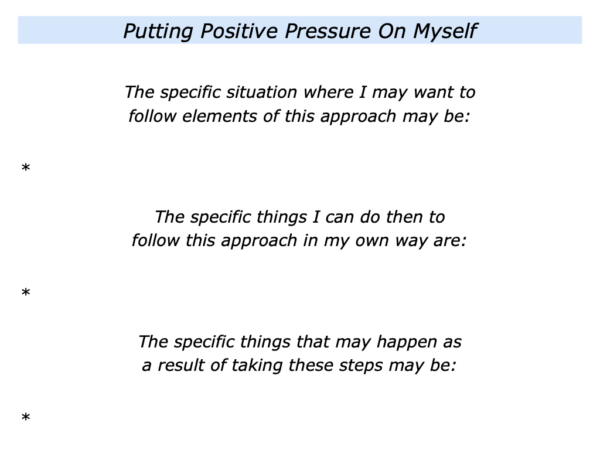






Leave a Reply